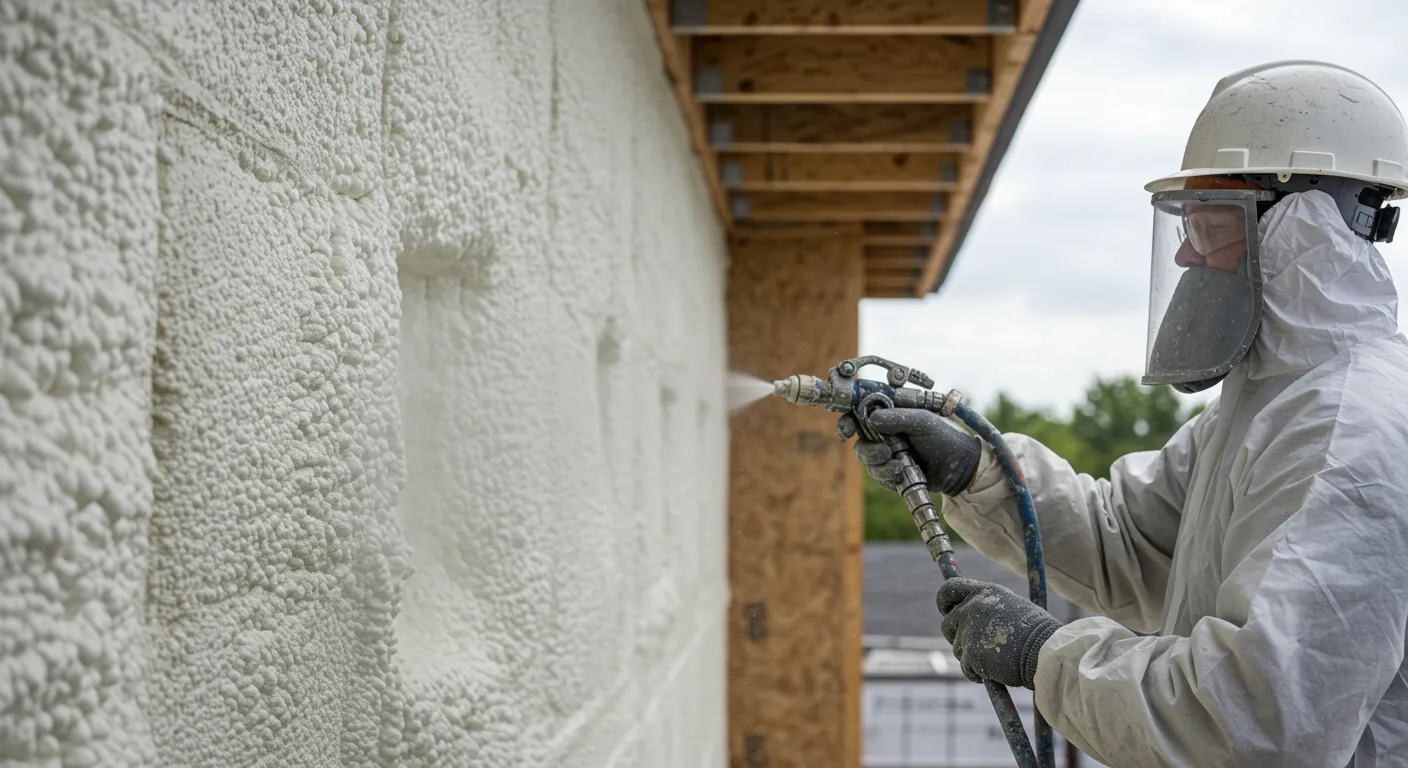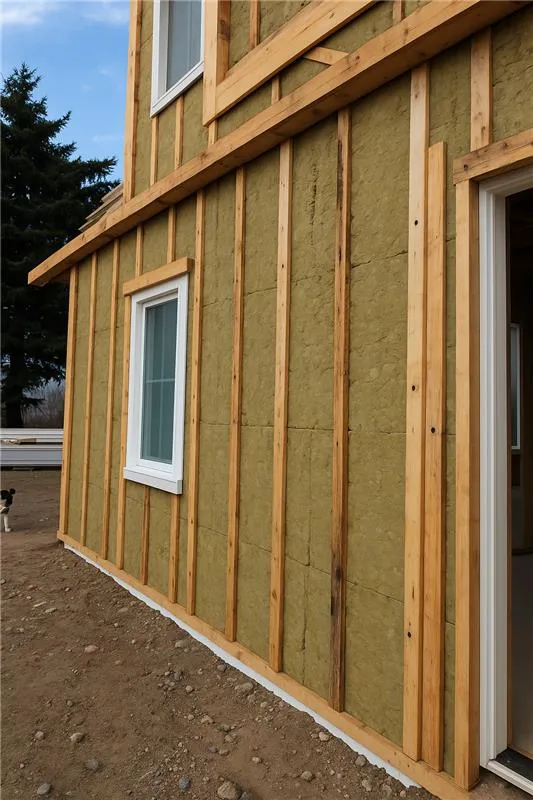Combining exterior insulation with spray foam offers a robust and energy-efficient solution for homeowners looking to enhance building performance, particularly in attics and wall assemblies. This hybrid insulation method significantly improves thermal resistance, controls moisture more effectively, and provides airtight sealing—all critical for maintaining interior comfort and reducing energy bills over time.
The system involves placing rigid foam insulation on the building’s exterior while applying exterior spray foam insulation inside the wall cavity or attic. When installed together, they create a continuous thermal envelope that outperforms traditional insulation methods. This article explores why this approach is gaining attention from professionals, particularly attic insulation experts, and outlines the technical details, benefits, and considerations involved in making an informed decision.
How the Hybrid System Enhances Building Performance
The combination works because each insulation material addresses different performance gaps. Exterior rigid foam insulation prevents thermal bridging—a major cause of energy loss where wood or metal framing transfers heat. Meanwhile, interior spray foam attic insulation fills cavities, seals gaps, and stops air infiltration. The result is a complete thermal and air barrier that performs year-round, regardless of climate zone.
Air leakage is one of the biggest reasons homes become uncomfortable and expensive to heat or cool. Using both insulation layers ensures that conditioned air stays inside, reducing HVAC cycling and wear. This leads to measurable improvements in heating and cooling efficiency. Attics in particular benefit because they are high-exposure areas where insulation often underperforms due to poor sealing or compressed materials.
For homes undergoing major renovations or new builds, professionals increasingly recommend this dual-insulation approach. It not only raises the effective R-value of wall and roof assemblies but also protects the structure from condensation damage, mold, and seasonal expansion and contraction stresses.
Technical Performance and Data
Understanding the technical specifications is essential when evaluating this hybrid insulation system. Each layer plays a unique role and contributes to the overall thermal performance:
| Component | Material Type | R-Value per Inch | Function | Notes |
|---|---|---|---|---|
| Rigid Foam Board | Polyiso, XPS, EPS | R-4 to R-6.5 | Blocks thermal bridging, adds external insulation | Choose thickness based on climate |
| Closed-Cell Spray Foam | Polyurethane | R-6 to R-7 | Air sealing, interior cavity insulation | Also functions as vapor barrier |
| Combined Assembly | Hybrid System | R-10 to R-14 | Total system performance | Outperforms cavity-only insulation |
What makes this hybrid system stand out is its ability to meet or exceed most current energy codes, especially when applied with precision. While attic insulation installation using traditional batts or blown-in materials may struggle with gaps and settling over time, spray foam maintains its form and adhesion. When paired with exterior foam, it ensures durability and consistency for decades.
In-Depth Comparison with Other Methods
To better understand the advantages, it’s important to compare the hybrid system with common insulation alternatives. This comparison shows where each system stands in terms of core performance factors:
| Feature | Fiberglass Batts | Spray Foam Alone | Exterior Foam Alone | Combined System |
|---|---|---|---|---|
| Thermal Bridging | High | Moderate | Low | None |
| Air Sealing | Poor | Excellent | Limited | Superior |
| R-Value Stability | Degrades Over Time | High | High | Consistent and durable |
| Moisture Resistance | Low | High | Depends on material | Comprehensive |
| Installation Quality Sensitivity | High | High | Moderate | Requires expertise |
| Energy Efficiency | Low | Moderate to High | Moderate | Highest |
In most applications, spray foam or exterior foam alone cannot solve both thermal and air sealing issues completely. It’s the combined use that addresses these problems in full. Attic insulation experts often encounter homes with inconsistent insulation layers that leave thermal gaps or let in moisture. This hybrid approach ensures neither is compromised.
Things to Consider Before Making a Decision
Not every home needs the most advanced insulation available, but for those seeking high-efficiency performance, durability, and comfort, this combined approach offers lasting results. Before deciding, it’s important to factor in several key elements.
Climate zone plays a major role. In colder areas, exterior insulation helps prevent condensation by keeping the sheathing warm, while in hotter climates it reduces solar heat gain and indoor temperature fluctuations. Matching the insulation type and thickness to your zone will help maximize efficiency.
Project scope is another consideration. If you are already replacing siding or reroofing, adding exterior foam becomes far more cost-effective. Retrofitting this system into an existing home without exterior renovations is possible but more complex and expensive.
Professional expertise is essential. This is not a system that performs well if installed poorly. A qualified attic insulation contractor must assess your home’s structure, current insulation levels, and moisture control systems before installation. Poor detailing at seams, transitions, or mechanical penetrations can reduce the system’s effectiveness.
Budget and payback should be analyzed, too. While the upfront cost can be higher than conventional options, the return on investment through energy savings is substantial—typically in the 3–6 year range, depending on location and energy prices. Long-term benefits include fewer HVAC repairs, lower energy bills, and increased indoor comfort.
Real-World Efficiency Gains
The U.S. Department of Energy reports that up to 30% of a building’s heating and cooling energy can be lost through poorly insulated envelopes. By using continuous exterior foam with spray foam, much of this energy loss is eliminated. In monitored homes, this combination has shown heating load reductions of up to 40% and cooling savings nearing 35% in some regions.
In colder regions like the Northeast or Midwest, preventing sheathing from dipping below the dew point is critical. Exterior insulation handles this by keeping surfaces warmer, while the interior spray foam ensures that indoor air doesn’t carry moisture into the wall cavity. Together, they offer a building envelope that manages both energy and moisture holistically.
Common Questions
Can you retrofit this system into an existing home?
Yes, but it’s more feasible when the home is undergoing major updates such as re-siding or roof replacement. The existing wall structure needs evaluation to ensure compatibility, and professional guidance is key to a successful outcome.
Is it necessary to use both types of insulation?
Using both insulation types is not strictly necessary, but it is the most effective way to eliminate energy loss and air leakage. Spray foam alone can’t block thermal bridging, and exterior foam alone can’t seal internal cavities. Their combined performance provides comprehensive coverage.
Does the system affect indoor air quality?
Yes, positively. By tightly sealing the envelope, it prevents outdoor pollutants, allergens, and humidity from entering. However, homes must also have adequate ventilation to maintain fresh indoor air.
How does it perform in humid or rainy climates?
This system is highly effective in moist climates. Closed-cell spray foam resists water absorption, while exterior foam reduces the chance of dew forming inside wall cavities. Proper detailing and flashing ensure water doesn’t enter around windows, doors, or other penetrations.
Can this approach work in cathedral ceilings or hard-to-reach attic areas?
Yes. In fact, spray foam is often the only practical solution for insulating tight spaces, and exterior foam complements this by improving performance without requiring access to interior framing.
Additional FAQs
How long does this insulation system last? With proper installation, it can last 50 years or more without significant degradation in performance.
What’s the best spray foam type to use? Closed-cell polyurethane is preferred due to its high R-value, structural strength, and water resistance.
Do I need a vapor barrier if I use this system? In most cases, closed-cell spray foam acts as a vapor barrier, especially when combined with exterior foam. Check your local code to verify.
What are the signs that my current attic insulation is underperforming? Uneven temperatures, high energy bills, drafts, or moisture issues in the attic may indicate it’s time to upgrade.
Is this system suitable for all building types? It’s most beneficial for residential and light commercial buildings, but adaptations can be made for larger structures depending on usage and climate conditions.
Final Takeaway
The combination of exterior insulation with spray foam attic insulation is one of the most effective strategies to boost energy efficiency, eliminate air leakage, and increase the longevity of your home. When properly installed by experienced attic insulation contractor professionals, this system transforms building performance far beyond what traditional methods can offer. The investment pays back in comfort, durability, and lower operating costs—especially when installed during major upgrades or new construction.
Always consider your climate, building condition, and long-term energy goals before moving forward. This system demands precise installation, but when done correctly, it delivers measurable, lasting benefits that justify the upfront investment.
Contact Information: Cascadia Spray Foam of Seattle 📞 (425) 386-3500 ✉️ [email protected]

Reviewer: Olivia Thompson has spent 10 years working in spray foam insulation, helping companies grow their visibility. She reviewed this article and provided valuable suggestions on how to better align the content with the needs and expectations of customers, ensuring it resonates with the target audience.










